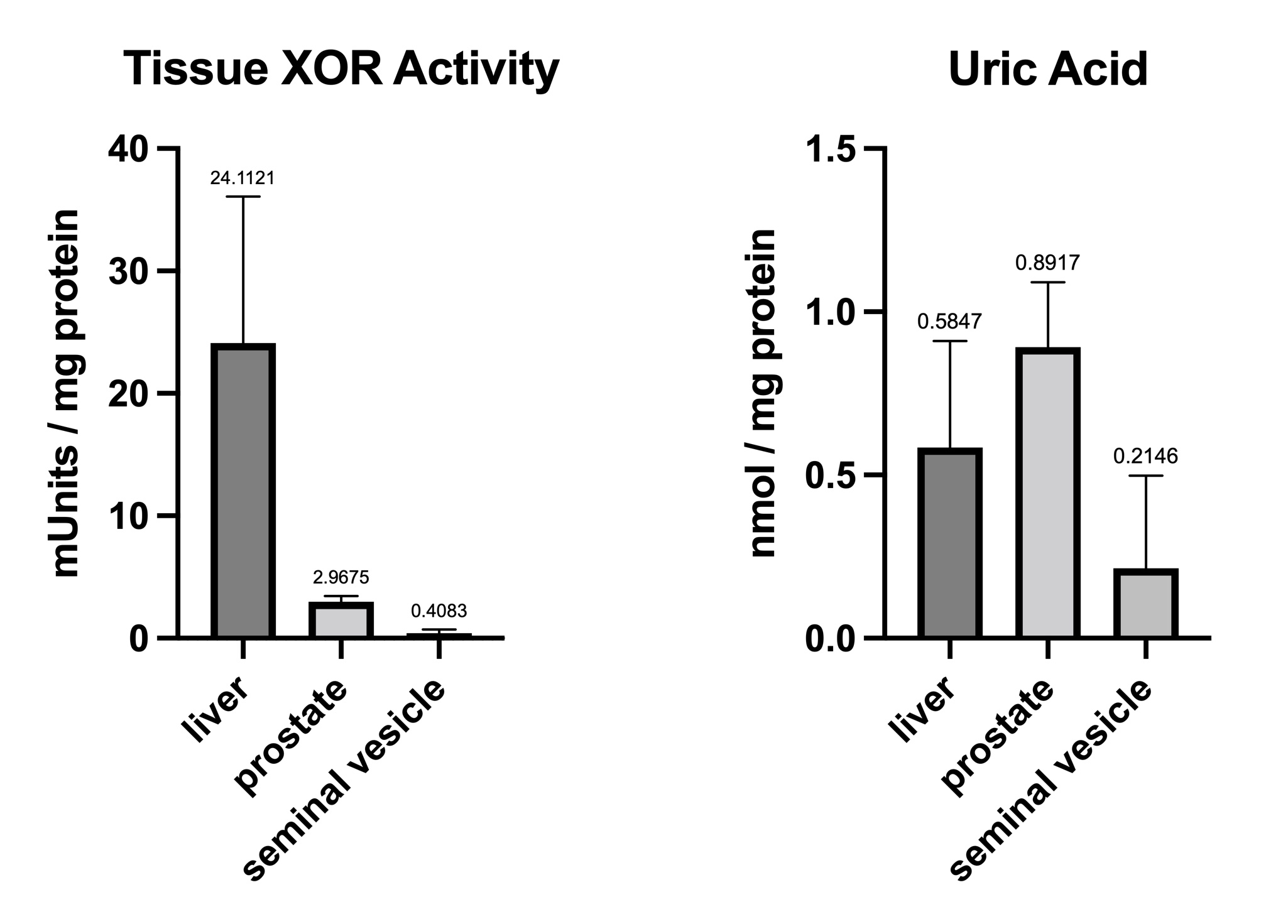Back
Poster Session C
Genetics, genomics and proteomics
Session: (1118–1149) Genetics, Genomics and Proteomics Poster
1145: The Prostate Plays a Role in Serum Urate Levels and the Risk of Gout in Men
Sunday, November 13, 2022
1:00 PM – 3:00 PM Eastern Time
Location: Virtual Poster Hall
- MU
Mariana Urquiaga, MD
University of Alabama at Birmingham
Birmingham, AL, United States
Abstract Poster Presenter(s)
Mariana Urquiaga1, Megan Leask1, Nicholas Sumpter1, Brooke Maxwell2, Sara Lewis2, Eric E. Kelley2 and Tony Merriman3, 1University of Alabama at Birmingham, Birmingham, AL, 2West Virginia University, Morgantown, WV, 3University of Otago, Dunedin, New Zealand
Background/Purpose: Men have higher serum urate (SU) and increased prevalence of gout compared to pre-menopausal women. Xanthine oxidoreductase (XOR), encoded by the XDH gene, is the sole enzyme responsible for urate production in mammals. In a gout GWAS study (Abstract ID 1288189) we identified a genetic association at the XDH locus with gout that co-localized with a genetic signal of control of XDH expression that is specific to the prostate. This finding has generated the novel hypothesis that the prostate plays a role in urate homeostasis and the risk of gout in men. This hypothesis is supported by evidence that urate is a constituent of semen1,2 and the presence of urate crystals in non-malignant prostate sections3. Here we tested for the expression of XDH and urate transporters in the human prostate and for XOR activity and uric acid in the murine prostate.
Methods: We used publicly-available single cell RNA sequencing data4 to evaluate the expression of XDH and urate transporters in specific cell types in the prostate. We measured uric acid concentration and XOR activity from the prostate of 7-week C57Bl/J6 mice.
Results: XDH is expressed in prostatic basal and urothelial cells (Figure 1). The major urate transporter genes ABCG2, SLC2A9, and ABCC4 (encoding ABCG2, GLUT9, and MRP4 respectively) were expressed in different prostate cell types (Figure 1), however expression of other urate transporters was negligible (data not shown). XDH and SLC2A9 had overlapping expression patterns in the basal and urothelial cells of the prostate. The secretory transporter ABCC4 was ubiquitously expressed, although predominantly in glandular cells. The expression of the secretory transporter ABCG2 was at a high level restricted to endothelial cells. In mice, XOR activity was higher in the liver than the prostate, however concentration of uric acid (per mg protein) was higher in the prostate (Figure 2).
Conclusion: XDH is expressed in the human prostate. In the mouse prostate, XOR is active and uric acid is synthesized. The presence of XDH and urate transporters in the prostate, provides a potential mechanism for prostatic production and secretion of urate into the blood. Production by XOR and transport of urate by GLUT9 in epithelial cells, combined with transport into the blood by ABCG2 is a testable model. Together, these results further support the hypothesis that the prostate may play a role in the increased urate levels and risk of gout in men.
 Cell-specific expression of XDH and urate transporters in the prostate. (Image credit: Human Protein Atlas, image available from v21.1.proteinatlas.org)
Cell-specific expression of XDH and urate transporters in the prostate. (Image credit: Human Protein Atlas, image available from v21.1.proteinatlas.org)
 Tissue XOR activity and urate levels in the liver, prostate, and seminal vesicles of male mice
Tissue XOR activity and urate levels in the liver, prostate, and seminal vesicles of male mice
Disclosures: M. Urquiaga, None; M. Leask, None; N. Sumpter, None; B. Maxwell, None; S. Lewis, None; E. Kelley, None; T. Merriman, None.
Background/Purpose: Men have higher serum urate (SU) and increased prevalence of gout compared to pre-menopausal women. Xanthine oxidoreductase (XOR), encoded by the XDH gene, is the sole enzyme responsible for urate production in mammals. In a gout GWAS study (Abstract ID 1288189) we identified a genetic association at the XDH locus with gout that co-localized with a genetic signal of control of XDH expression that is specific to the prostate. This finding has generated the novel hypothesis that the prostate plays a role in urate homeostasis and the risk of gout in men. This hypothesis is supported by evidence that urate is a constituent of semen1,2 and the presence of urate crystals in non-malignant prostate sections3. Here we tested for the expression of XDH and urate transporters in the human prostate and for XOR activity and uric acid in the murine prostate.
Methods: We used publicly-available single cell RNA sequencing data4 to evaluate the expression of XDH and urate transporters in specific cell types in the prostate. We measured uric acid concentration and XOR activity from the prostate of 7-week C57Bl/J6 mice.
Results: XDH is expressed in prostatic basal and urothelial cells (Figure 1). The major urate transporter genes ABCG2, SLC2A9, and ABCC4 (encoding ABCG2, GLUT9, and MRP4 respectively) were expressed in different prostate cell types (Figure 1), however expression of other urate transporters was negligible (data not shown). XDH and SLC2A9 had overlapping expression patterns in the basal and urothelial cells of the prostate. The secretory transporter ABCC4 was ubiquitously expressed, although predominantly in glandular cells. The expression of the secretory transporter ABCG2 was at a high level restricted to endothelial cells. In mice, XOR activity was higher in the liver than the prostate, however concentration of uric acid (per mg protein) was higher in the prostate (Figure 2).
Conclusion: XDH is expressed in the human prostate. In the mouse prostate, XOR is active and uric acid is synthesized. The presence of XDH and urate transporters in the prostate, provides a potential mechanism for prostatic production and secretion of urate into the blood. Production by XOR and transport of urate by GLUT9 in epithelial cells, combined with transport into the blood by ABCG2 is a testable model. Together, these results further support the hypothesis that the prostate may play a role in the increased urate levels and risk of gout in men.
 Cell-specific expression of XDH and urate transporters in the prostate. (Image credit: Human Protein Atlas, image available from v21.1.proteinatlas.org)
Cell-specific expression of XDH and urate transporters in the prostate. (Image credit: Human Protein Atlas, image available from v21.1.proteinatlas.org) Tissue XOR activity and urate levels in the liver, prostate, and seminal vesicles of male mice
Tissue XOR activity and urate levels in the liver, prostate, and seminal vesicles of male miceDisclosures: M. Urquiaga, None; M. Leask, None; N. Sumpter, None; B. Maxwell, None; S. Lewis, None; E. Kelley, None; T. Merriman, None.

